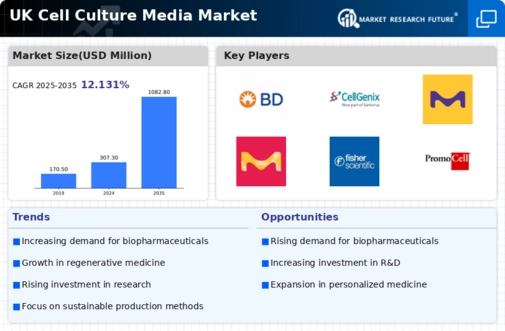Rising Biopharmaceutical Investments
The cell culture-media market in the UK is experiencing a notable surge in investments from biopharmaceutical companies. This trend is driven by the increasing demand for biologics and advanced therapies, which require sophisticated cell culture techniques. In 2025, the biopharmaceutical sector is projected to contribute approximately £3 billion to the overall market, highlighting the critical role of cell culture media in drug development. As companies seek to enhance their production capabilities, the need for high-quality media formulations becomes paramount. This investment influx not only supports research and development but also stimulates innovation within the cell culture-media market, fostering a competitive landscape that encourages the introduction of novel products and technologies.
Increased Focus on Quality Control Standards
Quality control standards are becoming increasingly stringent within the cell culture-media market in the UK. Regulatory bodies are emphasizing the need for consistent and reliable media formulations to ensure reproducibility in research and production. In 2025, it is estimated that compliance costs for manufacturers will rise by 20%, prompting them to invest in quality assurance measures. This heightened focus on quality is likely to drive innovation in media production processes, as companies strive to meet regulatory requirements while maintaining product efficacy. As a result, the cell culture-media market may witness a shift towards more standardized and validated media products, enhancing overall trust and reliability in the industry.
Expansion of Academic and Industrial Collaborations
The cell culture-media market is benefiting from the expansion of collaborations between academic institutions and industrial players in the UK. These partnerships are fostering knowledge exchange and driving innovation in media development. In 2025, it is projected that collaborative research initiatives will increase by 25%, leading to the creation of novel media formulations tailored to specific applications. Such collaborations not only enhance the research capabilities of academic institutions but also provide industry partners with access to cutting-edge scientific advancements. This synergy is likely to accelerate the growth of the cell culture-media market, as new products emerge from these collaborative efforts, addressing the diverse needs of researchers and manufacturers alike.
Growing Research Activities in Regenerative Medicine
The cell culture-media market is significantly influenced by the expanding research activities in regenerative medicine across the UK. Institutions and research facilities are increasingly focusing on stem cell research and tissue engineering, which necessitate specialized culture media. In 2025, funding for regenerative medicine research is expected to reach £1.5 billion, further propelling the demand for tailored cell culture media solutions. This growth indicates a shift towards more complex and customized media formulations that can support the unique requirements of regenerative therapies. Consequently, the cell culture-media market is likely to evolve, with manufacturers adapting their offerings to meet the specific needs of researchers and clinicians in this dynamic field.
Technological Advancements in Cell Culture Techniques
Technological advancements are playing a pivotal role in shaping the cell culture-media market in the UK. Innovations such as automated cell culture systems and high-throughput screening methods are enhancing the efficiency and scalability of cell culture processes. In 2025, the adoption of these technologies is anticipated to increase by 30%, leading to a greater demand for compatible media formulations. As researchers and manufacturers seek to optimize their workflows, the integration of advanced technologies with cell culture media becomes essential. This trend not only improves productivity but also drives the development of specialized media that can cater to the evolving needs of the industry, thereby fostering growth within the cell culture-media market.






















Leave a Comment